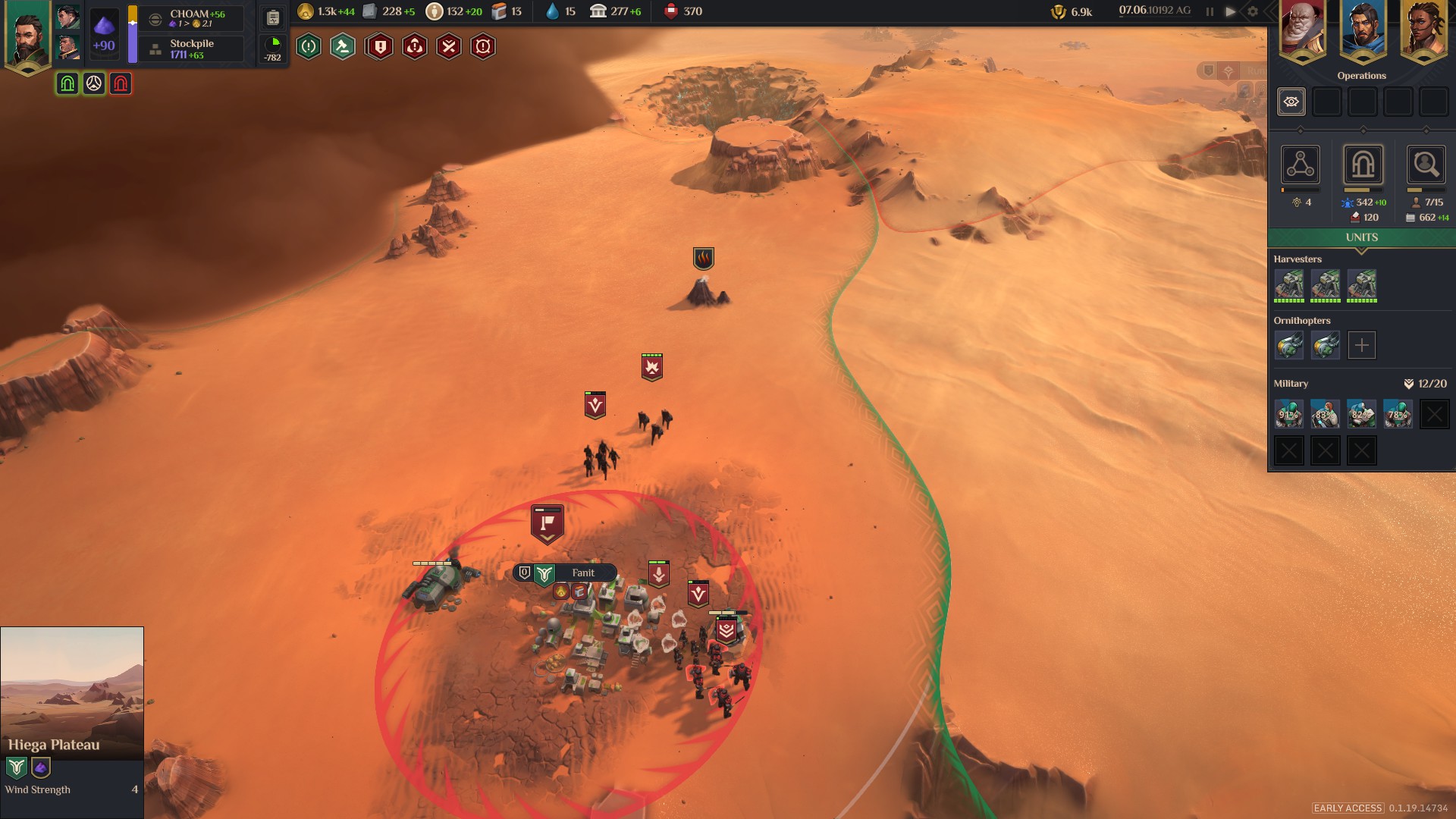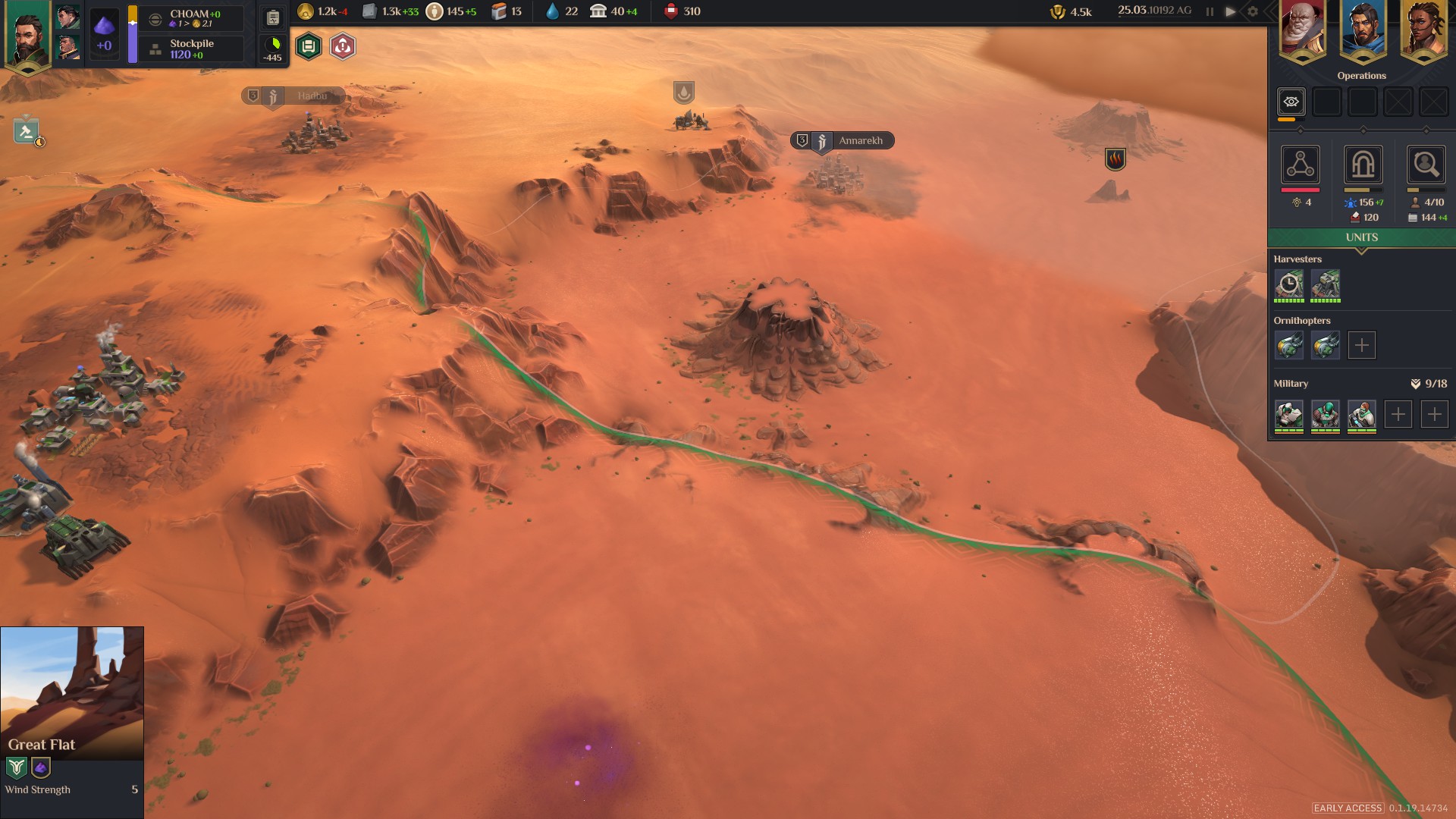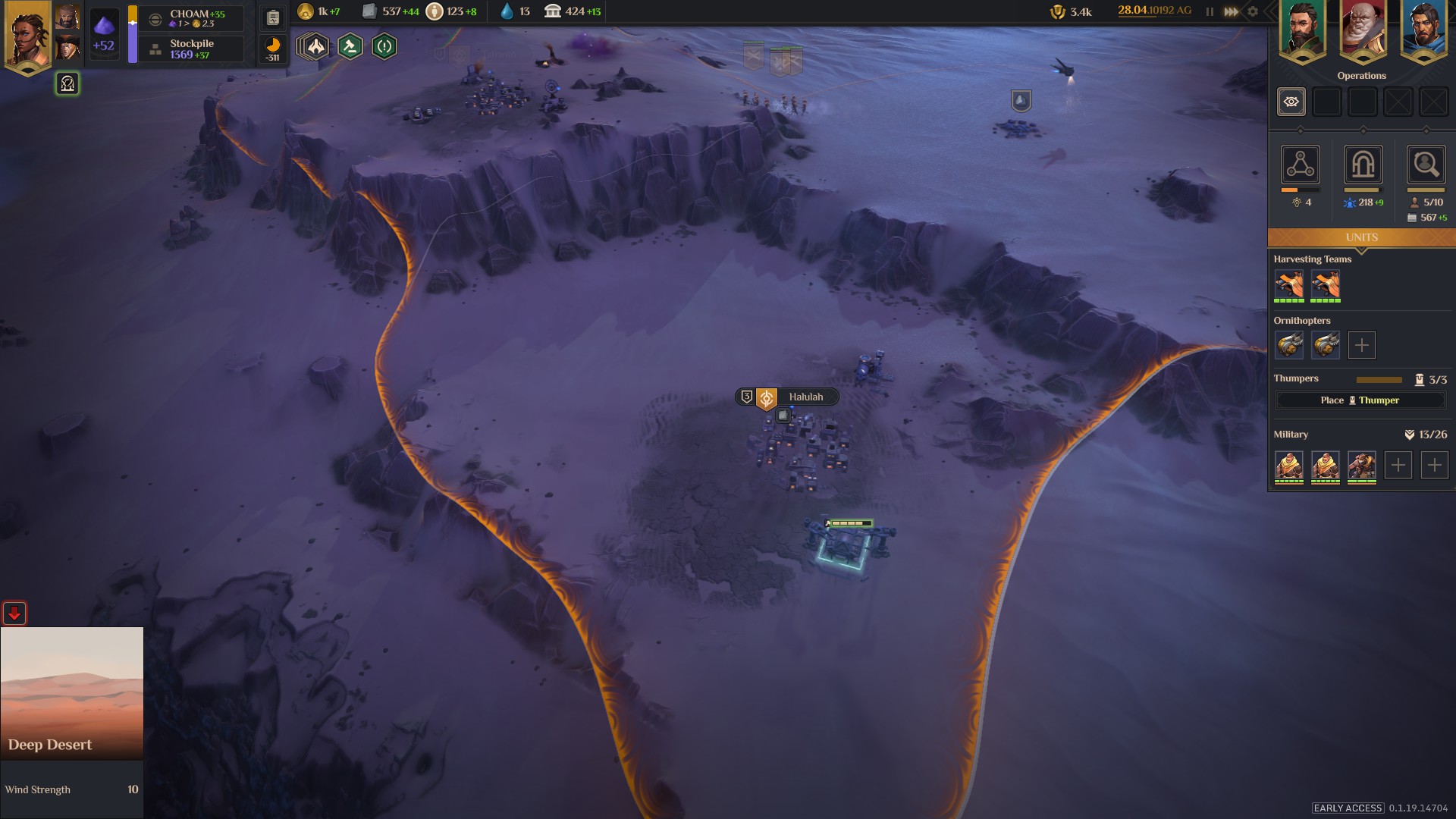With the Dune (2021) movie being a big hit with the public, hype for the series has been at an all-time high! Riding on the popularity of the series, Shiro Games has developed a 4X strategy game set in the same universe. Dune: Spice Wars showcases the power struggle between House Atreides, House Harkonnen, the Smugglers and the Fremen as they strike at each other for control of planet Arrakis. It’s up to the player to take control of one of these factions and take them to victory!
Dune: Spice Wars is a 4X strategy game developed by Shiro Games and published by Funcom Entertainment. The game came out for the PC platform in Early Access on Steam on April 26, 2022.

Fight for Arrakis!
Arrakis has a rare resource that all factions in the universe are eager to take control of – spice. Spice is used in the production of mind-altering drugs that is highly addictive in nature. Arrakis is the only planet where spice (also called spice melange) grows naturally – making it a very rare resource in the Imperium. Naturally, all of the Great Houses of the Landsraad as well as other factions (like the Smugglers and the Fremen) are eager to take control of it. And that is exactly what you fight for in Dune: Spice Wars – control of spice fields (as the name already implies). Saying “the Great Houses” might be a misnomer since you only get to play as two houses – House Atreides and House Harkonnen. The addition of more houses can just be something Shiro Games aims to do in the future. Northgard, one of their earlier strategy games, also launched in Early Access with a few clans with more clans launching as DLC later on. In fact, Shiro Games’ reputation for designing Northgard is probably why I decided to try their next big game. Moreover, I really liked the Dune franchise, having read the books and played the earlier games.
Dune: Spice Wars plays entirely different from the previous games. Unlike the previous games, it is a 4X strategy game and not a real-time strategy game. However, unlike traditional 4X games like Civilization, the game plays in real-time with all users playing together. In other words, it isn’t played with each user taking turns to make their moves. This unique mish-mash of genres makes the game stand out in the strategy genre. The popularity of the Dune franchise further cements its popularity in the strategy genre. However, in its current state, the game is pretty lacklustre in terms of content.

There is no game mode in the game as of the present. The only game mode is the traditional ‘Skirmish’ mode that most strategy games. There have been promises of a Campaign mode coming soon, but I’ll probably want the writers to take their time with the story and ship something worth playing instead of rushing something out which will be shot down by haters immediately. Writing a good story in the Dune universe is slightly complicated given that Frank Herbert had already laid out a path for events to unfold, but there’s still a lot of scope for creativity given that the previous Dune games did have innovative stories to tell.

Not everyone survives the desert
If you fast forward to the map of Dune, you would not be surprised to see sand everywhere on the map. Arrakis is a vast stretch of yellow with occasional villages for the folks that have taken up residence on the planet. These villages are the pawns in the great 4 player chessboard of the planet of Arrakis. Each region generally has a single village in control of it with militia guarding it. These militias have to be defeated before annexing it or plundering it for resources. Once annexed, the villages can be repurposed for producing resources. Some of the regions contain highly desirable spice fields, which can be harvested and sold to the CHOAM for making Solari (the equivalent of gold in the Dune universe). Solari and spice aren’t the only resources that one has to watch out for – there are plascrete, fuel cells, and water. If these are tangible, there are non-tangible resources like authority, influence, and knowledge that are used for progressing in the world. Each region has one or the other resource and needs to be annexed in order to be exploited. The game has managed to find a neat balance between the resources that one has to find in the world. Sadly, the same could not be said for the various factions contesting control of Arrakis.
Of course, if you’ve not realized it yet – your population is your biggest resource. Keeping your villages happy and protected will enable them to provide special bonuses to your empire. The population is used in filling up mining crews for gathering spice, and for manning buildings inside a village. I’d be even more pleased if the population was used for recruiting soldiers from the villages themselves, but for some reason, soldiers are always recruited in front of the capital. If your population is unhappy, you can expect shadow markets to operate against you or even full-scale rebellion by the villagers. The only option to quell them is to take them out in glorious combat and ensure their needs are satisfied. One of the most important requirements to keep villages under check is to ensure water supplies are always high.

At times, you’d feel overwhelmed with the amount of information that the game wants you to process, all while planning out future moves. Yes, the game expects you to fight back a territorial invasion by an enemy faction while a sandworm engulfs one of your spice harvesters and a rebellion is going on in one of the villages on the fringes of your territory. Your best companion is probably the time controller, which allows you to pause the flow of time as well as increase or decrease their speed. I found myself pausing the game a lot to make decisions one at a time and not stumble face upon the consequences of a lot of wrong calls all at once. Yeah, I’m not a big fan of the amalgamation of real-time strategy and the 4X genres. Most of the games that I have played often end up where I have messed up horribly with a lot of stuff happening at once – being forced to start afresh from a new game.
If you’re aiming to play a game with a minimal number of confusing modals with micro-management beyond the understanding of an ordinary human being, you’ve come to the right place. Unlike most 4X games, Dune: Spice Wars aims to keep it minimal by nature. The only three models that you will see are the Science tab (for deciding what technology to research to make more progress), the Espionage tab (for deciding who or what to spy on) and the Landsraad tab (for deciding which resolution to support or oppose in the Landsraad Council). The Espionage and Landsraad modals do seem a bit unintuitive at first, but after a few games, you will get the hang of it.

The game’s diplomacy is simply a carry-over from traditional 4X games like Civilization. One has to propose their offer and add some extras to that to ensure the offer gets accepted. The amount of extras depends on your relations with them at any point in time. You’ll also have the option of allying with the natives who stay hidden in caves called Sietches by trading water with them for some other benefits (since lorewise they’re still Fremen). High relationship values can be articulated into alliances which benefit your empire in numerous ways like trade deals, treaties, resource sharing and so much. I feel that there have not been any extra additions here, but then again it’s difficult to add features and keep it simple at the same time. There’s also the Landsraad Council who have to be appeased in order for the players to extract benefits out of them. The Council meets for passing resolutions every month. These resolutions can be used to benefit your empire or hurt your enemies, which is a very neat and well-designed strategic feature in my opinion (even though it took me quite some time to figure out how to use this to my advantage).

50 Shades Of Yellow
Arrakis is a desert planet by nature, so you’ll be seeing a lot of yellow in Dune: Spice Wars. It seems like different shades of yellow made up the palette that was used to color the landscapes, which has little variety otherwise. After a few games, the colors used seem a bit drab and repetitive like the special Instagram filter used by Hollywood whenever they are making films in Latin America. The game also lacks a decent view distance, meaning that if you wanted to inspect your units or buildings up close, you cannot do it. I guess this was done keeping performance considerations in mind, but some exceptions could be made for extending the view distance a bit.

The game does have a few performance inconsistencies now. While framerate does seem to be constant throughout the playthroughs, there were a few inconsistent freezes – especially when a lot of stuff is happening on the screen or a modal is fired up. Considering that the game is in Early Access, these issues can easily be fixed if they are targeted earlier on.

The Great Conclusion
Dune: Spice Wars is perfectly poised to be the meta-defining 4X real-time strategy game in the market. However, the lacklustre amount of game content as well as the repetitive gameplay does hurt the game’s replayability. There also seem to be some performance issues, albeit mild, which hinder the player’s experience. I would definitely recommend waiting out for a sale for this one if you are really keen on trying out another new addition to the strategy genre. If you’re not a big fan of strategy games and just wanted to try the game out because it’s set in the Dune universe, I’d reckon you’d have to look elsewhere.
INITIAL RATING – RECOMMENDED




1 comment